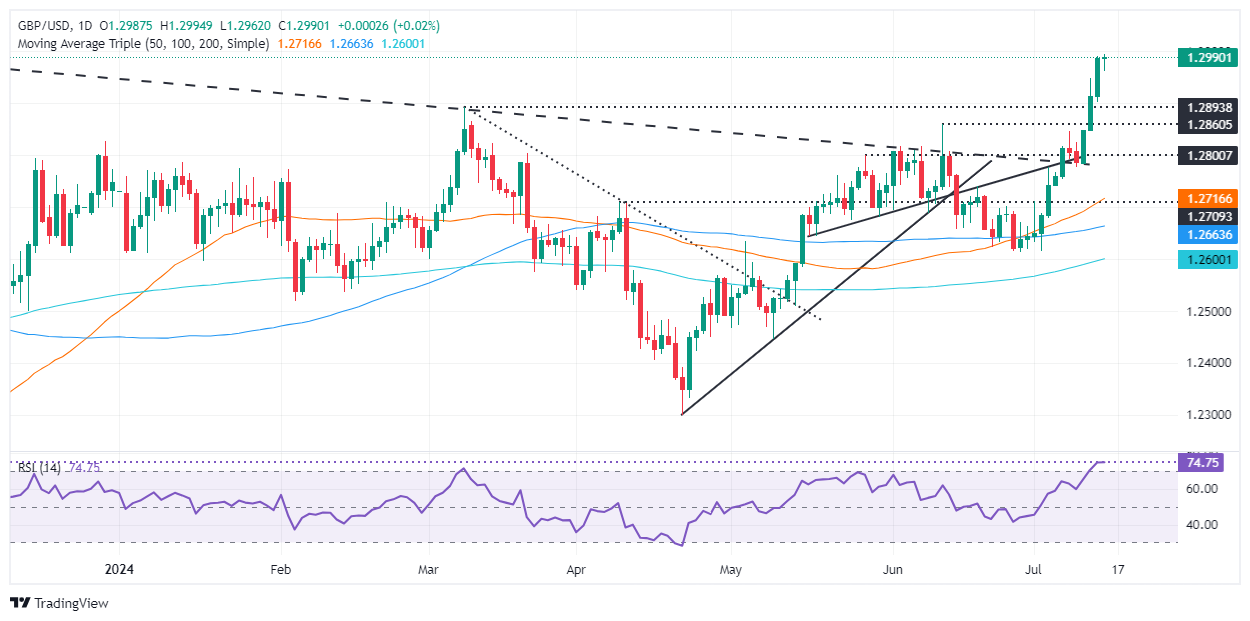GBP/USD Price Analysis: Surges and approaches to 1.3000
- GBP/USD approaches 1.2985, close to a 12-month high of 1.2995, propelled by strong bullish momentum.
- Resistance levels identified at 1.2995-1.3000, 1.3041 (July 19 high), and 1.3126 (July 18 peak).
- Support levels to monitor for potential reversals: 1.2901 (July 12 low), 1.2860 (June 12 peak), 1.2779 (July 10 low).
The Pound Sterling resumes its rally as the North American session begins. It faded earlier US Dollar strength, spurred by a shooting at former US President Donald Trump's rally in Pennsylvania, which triggered a flight to safety. The GBP/USD trades at 1.2985 and gains 0.24%.
GBP/USD Price Analysis: Technical outlook
Following last week's three-day advance since Wednesday, the 1.3000 figure is up for grabs, with the GBP/USD trading near a 12-month high yet shy of the July 27, 2023, high of 1.2995.
Momentum remains bullish, though it has shifted overbought, but due to the strength of the uptrend, some traders see the 80 level as the most extreme.
Therefore, the GBP/USD next resistance would be 1.2995-1.3000. Once that level is cleared, the next stop would be July 19, 2023, high at 1.3041, before testing the July 18, 2023, peak of 1.3126. Up next would be last year's high at 1.3142.
Conversely, if GBP/USD sellers stepped in, they must push prices below the July 12 low of 1.2901. In the event of a reversal, the next stop would be the June 12 peak turned support at 1.2860 before slumping to the July 10 low of 1.2779.
GBP/USD Price Action – Daily Chart
Pound Sterling FAQs
The Pound Sterling (GBP) is the oldest currency in the world (886 AD) and the official currency of the United Kingdom. It is the fourth most traded unit for foreign exchange (FX) in the world, accounting for 12% of all transactions, averaging $630 billion a day, according to 2022 data. Its key trading pairs are GBP/USD, aka ‘Cable’, which accounts for 11% of FX, GBP/JPY, or the ‘Dragon’ as it is known by traders (3%), and EUR/GBP (2%). The Pound Sterling is issued by the Bank of England (BoE).
The single most important factor influencing the value of the Pound Sterling is monetary policy decided by the Bank of England. The BoE bases its decisions on whether it has achieved its primary goal of “price stability” – a steady inflation rate of around 2%. Its primary tool for achieving this is the adjustment of interest rates. When inflation is too high, the BoE will try to rein it in by raising interest rates, making it more expensive for people and businesses to access credit. This is generally positive for GBP, as higher interest rates make the UK a more attractive place for global investors to park their money. When inflation falls too low it is a sign economic growth is slowing. In this scenario, the BoE will consider lowering interest rates to cheapen credit so businesses will borrow more to invest in growth-generating projects.
Data releases gauge the health of the economy and can impact the value of the Pound Sterling. Indicators such as GDP, Manufacturing and Services PMIs, and employment can all influence the direction of the GBP. A strong economy is good for Sterling. Not only does it attract more foreign investment but it may encourage the BoE to put up interest rates, which will directly strengthen GBP. Otherwise, if economic data is weak, the Pound Sterling is likely to fall.
Another significant data release for the Pound Sterling is the Trade Balance. This indicator measures the difference between what a country earns from its exports and what it spends on imports over a given period. If a country produces highly sought-after exports, its currency will benefit purely from the extra demand created from foreign buyers seeking to purchase these goods. Therefore, a positive net Trade Balance strengthens a currency and vice versa for a negative balance.

